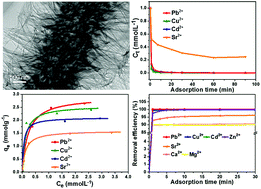One-dimensional zirconium-doped titanate nanostructures for rapid and capacitive removal of multiple heavy metal ions from water†
Abstract
We report a novel, one-dimensional zirconium-doped layered trititanate with a porous core and a textured surface of ultrafine nanofibers (∼5 nm) by the hydrothermal alkaline treatment of electrospun fibers. It demonstrates superior efficiency for rapid, capacitive and simultaneous removal of multiple heavy metal ions such as Pb2+, Cd2+, Cu2+ and Zn2+. The adsorption is exceptionally rapid, showing 100% removal of Cu2+ in 10 min, and 100% removal of Pb2+ and Cd2+ in 20 min in water with a wide range of concentrations from 0.1 to 5 mmol L−1. It displays an extraordinary adsorption capacity for highly toxic Pb2+ (2.91 mmol g−1). The sorption isotherms for Pb2+, Cd2+, Cu2+ and Sr2+ agree with the Langmuir model, indicating a monolayer adsorption. Corresponding sorption kinetics follow a pseudo-second-order model, suggesting a chemisorption-controlled adsorption process operating under the soft–hard Lewis acid–base principle. The crystal structure of the layered structure is retained after the ion-exchange process, endowing it with promising potential for the remediation of heavy metal contaminated water.



 Please wait while we load your content...
Please wait while we load your content...